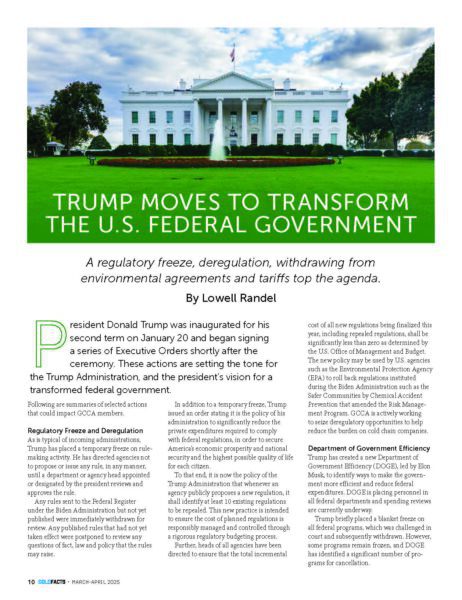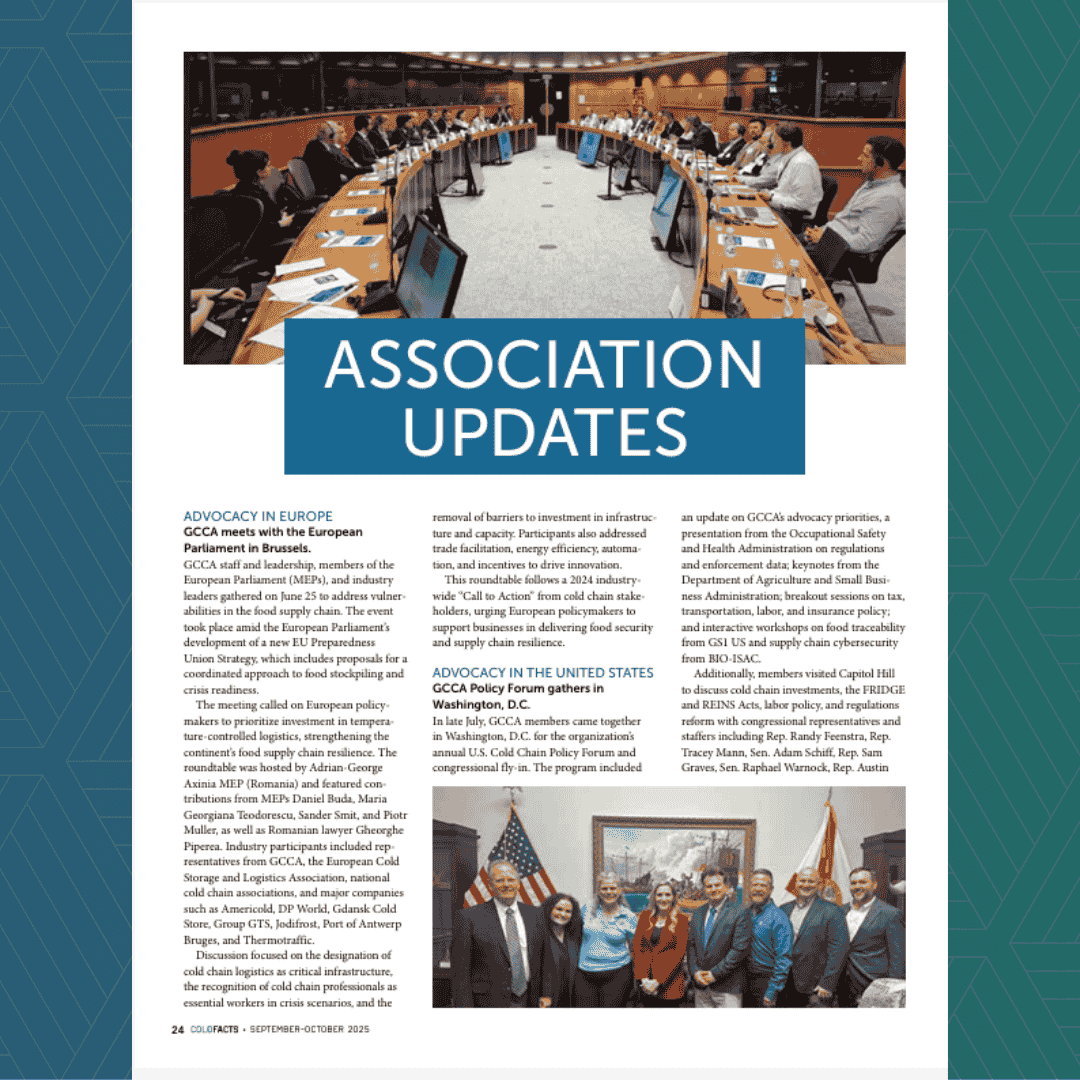From COLD FACTS Magazine (Click Image)
Read Below:
Trump Moves to Transform the U.S. Federal Government
A regulatory freeze, deregulation, withdrawing from environmental agreements and tariffs top the agenda.
By Lowell Randel
President Donald Trump was inaugurated for his second term on January 20 and began signing a series of Executive Orders shortly after the ceremony. These actions are setting the tone for the Trump Administration, and the president’s vision for a transformed federal government.
Following are summaries of selected actions that could impact GCCA members.
Regulatory Freeze and Deregulation
As is typical of incoming administrations, Trump has placed a temporary freeze on rulemaking activity. He has directed agencies not to propose or issue any rule, in any manner, until a department or agency head appointed or designated by the president reviews and approves the rule.
Any rules sent to the Federal Register under the Biden Administration but not yet published were immediately withdrawn for review. Any published rules that had not yet taken effect were postponed to review any questions of fact, law and policy that the rules may raise.
In addition to a temporary freeze, Trump issued an order stating it is the policy of his administration to significantly reduce the private expenditures required to comply with federal regulations, in order to secure America’s economic prosperity and national security and the highest possible quality of life for each citizen.
To that end, it is now the policy of the Trump Administration that whenever an agency publicly proposes a new regulation, it shall identify at least 10 existing regulations to be repealed. This new practice is intended to ensure the cost of planned regulations is responsibly managed and controlled through a rigorous regulatory budgeting process.
Further, heads of all agencies have been directed to ensure that the total incremental cost of all new regulations being finalized this year, including repealed regulations, shall be significantly less than zero as determined by the U.S. Office of Management and Budget. The new policy may be used by U.S. agencies such as the Environmental Protection Agency (EPA) to roll back regulations instituted during the Biden Administration such as the Safer Communities by Chemical Accident Prevention that amended the Risk Management Program. GCCA is actively working to seize deregulatory opportunities to help reduce the burden on cold chain companies.
Department of Government Efficiency
Trump has created a new Department of Government Efficiency (DOGE), led by Elon Musk, to identify ways to make the government more efficient and reduce federal expenditures. DOGE is placing personnel in all federal departments and spending reviews are currently underway.
Trump briefly placed a blanket freeze on all federal programs, which was challenged in court and subsequently withdrawn. However, some programs remain frozen, and DOGE has identified a significant number of programs for cancellation.
Hiring Freeze, Return to Work and Federal Workforce Reduction
The Trump Administration is taking aggressive steps to transform the federal workforce beginning with a hiring freeze and mandating that all workers return to the office in person. Heads of all departments and agencies in the executive branch of government are directed to take all necessary steps to terminate remote work arrangements and require employees to return to work in person at their respective duty stations on a full-time basis.
In an effort to reduce the federal workforce, the Office of Personnel Management (OPM) sent federal employees a buyout offer allowing them to resign immediately and retain their pay and benefits through September 30, 2025. It has been reported that approximately 75,000 employees (roughly 3% of the federal workforce) accepted the offer.
Once the offer closed, agencies began to implement “reductions in force” starting with probationary employees. The total number of employees being targeted for reduction is not clear at this time, but administration officials have indicated that further efforts to reduce the workforce are expected.
When the hiring freeze is lifted, agencies will be permitted to hire no more than one employee for every four employees that depart. Changes to the federal workforce could impact how regulatory agencies including the EPA, Occupational Safety and Health Administration, Department of Agriculture and Food and Drug Administration conduct enforcement and engage with industry.
Tariffs
Another policy area that has been subject to numerous executive actions is the use of tariffs.
During the campaign, Trump indicated his intention to utilize tariffs to achieve policy goals as well as rebalance what he sees as unfair trade relationships. Trump has ordered 25% tariffs on Canada and Mexico to pressure them to focus more resources on border security and address fentanyl trafficking. Those tariffs were paused for 30 days as both countries committed to dedicating additional resources to the border.
China has also been hit with an additional 10% tariff on imports citing its role in the production and movement of fentanyl. In addition, new 25% tariffs have also been placed on all aluminum and steel imports, similar to a move Trump made during his first term. Trump is also taking action to implement reciprocal tariffs on countries that are currently placing tariffs on American goods.
Depending on the duration of the tariffs and retaliatory measures taken by trading partners, it is expected that inflationary pressures will mount. This could impact food prices, materials needed for construction and a variety of other goods.
Putting America First in Environmental Agreements
Similar to his first term, Trump has taken action to withdraw the United States from international environmental agreements. This order directed the immediate withdrawal from the Paris Agreement under the United Nations Framework Convention on Climate Change. It also calls for withdrawal from any agreement, pact, accord, or similar commitment made under the United Nations Framework Convention on Climate Change.
It is unclear at this point whether the Trump Administration will move to roll back actions taken under the American Innovation & Manufacturing (AIM) Act to phase down HFCs, consistent with the Kigali Amendment to the Montreal Protocol. The AIM Act had bipartisan support when it passed Congress, and several key rules, such as the Technology Transitions Rule, have been finalized for some time.
However, a recently enacted rule entitled “Management of Certain HFCs and Their Substitutes Under the AIM Act” is currently in the window for potential cancellation under the Congressional Review Act (CRA). The CRA is a tool that allows Congress to cancel regulations finalized within a certain timeframe. Passage requires a simple majority in the House and Senate and presidential signature. Use of the CRA has historically come after a change in administration, such as the current situation.
While it is too early to know the longer-term impacts of Trump’s early executive actions, it is clear that his administration is working to transform how the federal government does business. GCCA will continue to engage with policymakers in the Trump Administration and Congress to navigate the evolving landscape and proactively advocate for the cold chain industry.
GCCA Applauds Introduction of the FRIDGE Act
The GCCA applauds the introduction of the Fortifying Refrigeration Infrastructure and Developing Global Exports (FRIDGE) Act in the U.S. House of Representatives and the Senate on March 25. The FRIDGE Act would add authority to the Trade Title of the Farm Bill to focus on strengthening the global food supply chain for frozen and refrigerated products.
“The GCCA strongly supports the FRIDGE Act and thanks Representatives Feenstra (R-IA), Mann (R-KS), Costa (D-CA) and Carbajal (D-CA); and Senators Banks (R-IN) and Fetterman (D-PA) for their leadership in introducing this important legislation,” says Sara Stickler, GCCA President and CEO. “Given the current uncertainties with tariffs and trade agreements, developing new markets for U.S. products will be extremely important. One of the biggest barriers to increasing trade in emerging markets is the lack of cold chain capacity. The FRIDGE Act would strengthen the ability of these markets to safely and efficiently receive high-quality U.S. perishable commodities, creating new trade opportunities, improving food security and nutrition, and reducing food loss and waste.”
GCCA was a strong proponent of the original 2023 bipartisan introduction of the FRIDGE Act in the House and the Senate, which was subsequently included in both the House and Senate versions of the Farm Bill in 2024.
GCCA appreciates the continued bipartisan commitment to strengthening the cold chain, and recognizing its critical role in supply chain resilience and food security.




